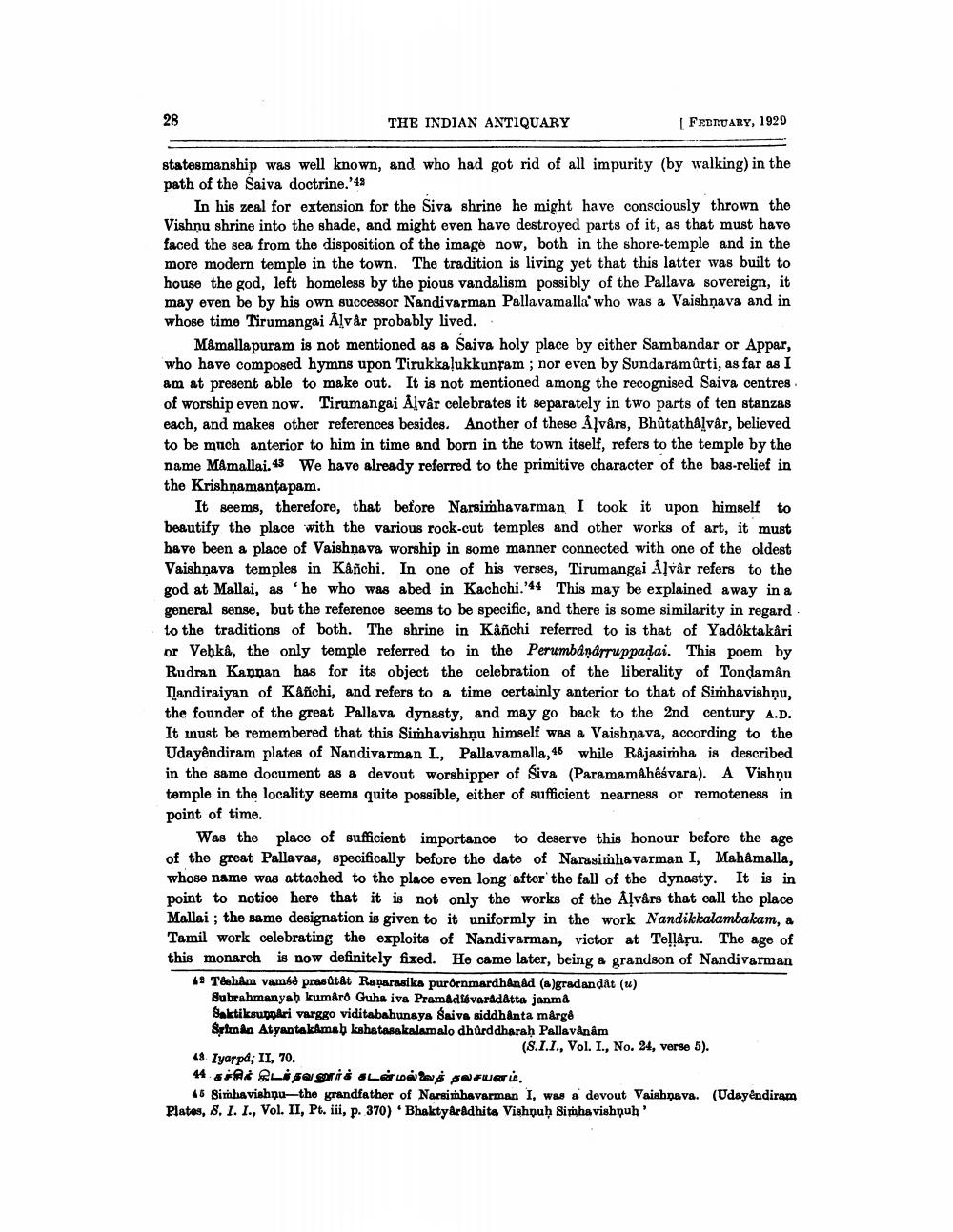________________
THE INDIAN ANTIQUARY
[ FENUARY, 1929
statesmanship was well known, and who had got rid of all impurity (by walking) in the path of the Saiva doctrine.'49
In his zeal for extension for the Siva shrine he might have consciously thrown the Vishņu shrine into the shade, and might even have destroyed parts of it, as that must have faced the sea from the disposition of the image now, both in the shore-temple and in the more modern temple in the town. The tradition is living yet that this latter was built to house the god, left homeless by the pious vandalism possibly of the Pallava sovereign, it may even be by his own successor Nandivarman Palla vamalla' who was a Vaishnava and in whose time Tirumangai Alvår probably lived..
Mamallapuram is not mentioned as a Saiva holy place by either Sambandar or Appar, who have composed hymns upon Tirukkalukkuntam; nor even by Sundaramûrti, as far as I am at present able to make out. It is not mentioned among the recognised Saiva centres of worship even now. Tirumangai Alvar celebrates it separately in two parts of ten stanzas each, and makes other references besides. Another of these Aļvârs, Bhutathålvår, believed to be much anterior to him in time and born in the town itself, refers to the temple by the name Mamallai.43 We have already referred to the primitive character of the bas-relief in the Krishnamantapam.
It seems, therefore, that before Narsimhavarman I took it upon himself to beautify the place with the various rock-cut temples and other works of art, it must have been a place of Vaishnava worship in some manner connected with one of the oldest Vaishṇava temples in Kanchi. In one of his verses, Tirumangai Alvår refers to the god at Mallai, as 'he who was abed in Kachchi.'44 This may be explained away in a general sense, but the reference seems to be specific, and there is some similarity in regard to the traditions of both. The shrine in Kanchi referred to is that of Yadôktakari or Vehka, the only temple referred to in the Perumbandsruppadai. This poem by Rudran Kappan has for its object the celebration of the liberality of Tondamån Ilandiraiyan of Kanchi, and refers to a time certainly anterior to that of Simhavishņu, the founder of the great Pallava dynasty, and may go back to the 2nd century A.D. It inust be remembered that this Simhavishnu himself was a Vaishnava, according to the Udayêndiram plates of Nandivarman I., Pallavamalla, 46 while Rajasimha is described in the same document as a devout worshipper of Siva (Paramamahêśvara). A Vishņu temple in the locality seems quite possible, either of sufficient nearness or remoteness in point of time.
Was the place of sufficient importance to deserve this honour before the age of the great Pallavas, specifically before the date of Narasimhavarman I, Mahamalla, whose name was attached to the place even long after the fall of the dynasty. It is in point to notice here that it is not only the works of the Aļvårs that call the place Mallai ; the same designation is given to it uniformly in the work Nandikkalambakam, a Tamil work celebrating the exploits of Nandivarman, victor at Tel?Aşu. The age of this monarch is now definitely fixed. He came later, being a grandson of Nandivarman 11 Thám vambé prasatat Raņarasika pur Ornmardhanad (a)gradandat (u)
Subrahmanyah kumår Guha iva PramadevaradAtta janmå Baktiksupiri varggo viditabahunaya Saiva siddhanta marge Srlin AtyantakAmab kahetasakalamalo dhårddharah Pallavånám
(8.1.1., Vol. I., No. 24, verse 5). 18. Iyarpa, II, 70. 44 கச்சிக் கிடந்தவனூர்க் கடன் மல்லைத் தலசயனம்,
46 Simba vishnu-the grandfather of Narsimhavarman I, was a devout Vaishnava. (Udayêndiram Plates, S. 1. I., Vol. II, Pt. iii, p. 370) Bhakty&radhite Vishnuh Sirisha vishnuh'




